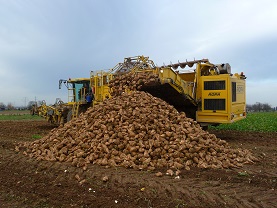In our first article on green chemistry we stressed the role of bio catalysis. This leads to a preference for feedstock from agriculture, at first in the small-scale fine chemical industry and now also in the developing green large-scale bulk chemical industry. For bio catalysis, working with enzymes, means imitation of nature, letting its forces work for us. And the fastest way to do that is by using natural compounds or substances much alike: in short, bio-based feedstock, agricultural products. This will lead to a cooperation of agriculture and chemical industry.
This is the second article in a series on green chemistry. The articles appeared on 5 June, 14 June, 19 June and 12 July 2015.

Conflict zone
Having established the preference of green chemical industry for agricultural resources, we find ourselves in the middle of a social and political conflict zone. For whereas almost everyone will hail the advent of a green chemical industry because of its inherent sustainability, things might be slightly different for an industry that will use part of agricultural production. We vividly remember the recent food/fuel discussion, and the conflict zone it represented is still there. And yet, both aspects, a sustainable industry and the use of agricultural products, are intimately interlinked. In the early stages, green chemical industry will even prefer to use edible agricultural products as its feedstock, for precisely the same reasons that our bodies prefer them: they are more readily processed by enzymes. Even though ‘second generation technologies’ are in full development that will assist in processing the non-edible (cellulose-based) components of agricultural production. But we cannot expect that these will lead to major amounts of cheap industrial feedstock at a short notice.
Existing and new opportunities for agriculture and chemical industry
And yet, this use of biobased feedstock need not be fatal. Firstly, chemical industry needs much less feedstock than energy supply: over 90% less! Secondly, green chemical industry is still in its infancy, with a concomitant low demand for biobased feedstock. And thirdly, there are many opportunities for an increase of agricultural production, even to such an extent that demand for feedstock for the chemical industry is dwarfed by it. Take the example of Europe, where production of sugar (one of the best resources for the green chemical industry) has been restricted for many years, in order to prevent overproduction. After 2017, the year in which European sugar production will be deregulated, North-western Europe by itself will be able to produce an additional 5 million tons (at a total European production of 16 million tons), an amount that can be sold to industry without any problem. For the productivity of sugar beets increases to such an extent that not much extra land needs to be taken into production. It will be sufficient to take into production again the land that has been taken out of production in recent years (in order to prevent overproduction).

But it goes without saying that industrial use of agricultural resources now on the market is just the beginning. In his valedictory speech as a professor at Wageningen UR, Johan Sanders estimated that half of present chemical industry may switch to biobased feedstock (for the other half, fossil fuels will remain the cheapest feedstock). But as indicated, this is just the beginning. A new search will start for new opportunities on the basis of biobased feedstock. As a matter of fact, that search has started already. At the opposite end of the imaginary line between chemistry and agriculture, researchers have intensified their search for industrially useful plant ingredients in the present agricultural production. They found many useful substances: for use in cosmetics, pesticides, preservatives etc. (link in Dutch). And it is useful to note that many plant ingredients have been used for industrial products for a long time already, possibly the largest quantities in the use of millions of tons of potato starch for the production of paper, glues, additives to plaster etc.
Agriculture and chemical industry move closer
In the next stage, agriculture and chemical industry will move closer. Farmers and agricultural researchers ask themselves: which ingredients in our agricultural production are promising for use in chemical industry? Can we change our varieties that have been optimised for human consumption for ages, in such a way that they could also be used in industry? Selling the yield to both markets? And chemical industry will ask itself: what new opportunities will biobased feedstock lend us? This latter search has shown successes in quite a number of ways already, the most visible being that of the advent of bioplastic PLA, supported by companies like Corbion and NatureWorks. New products come to the market with applications unheard of so far. Like starch plastics, used for biodegradable bed-pans and urinals, now successfully sold by Pharmafilter to hospitals.
We can hardly imagine all opportunities that a closer cooperation of agriculture and chemical industry will open up to us. This development has only just started. Is it haughtiness to suppose that this process will fuel the next wave of economic development? Certainly not, for so far we have not mentioned agricultural side streams at all. Those side streams have twice the volume of our entire human food production. In short, they are in such ample supply that green growth is just around the corner.
